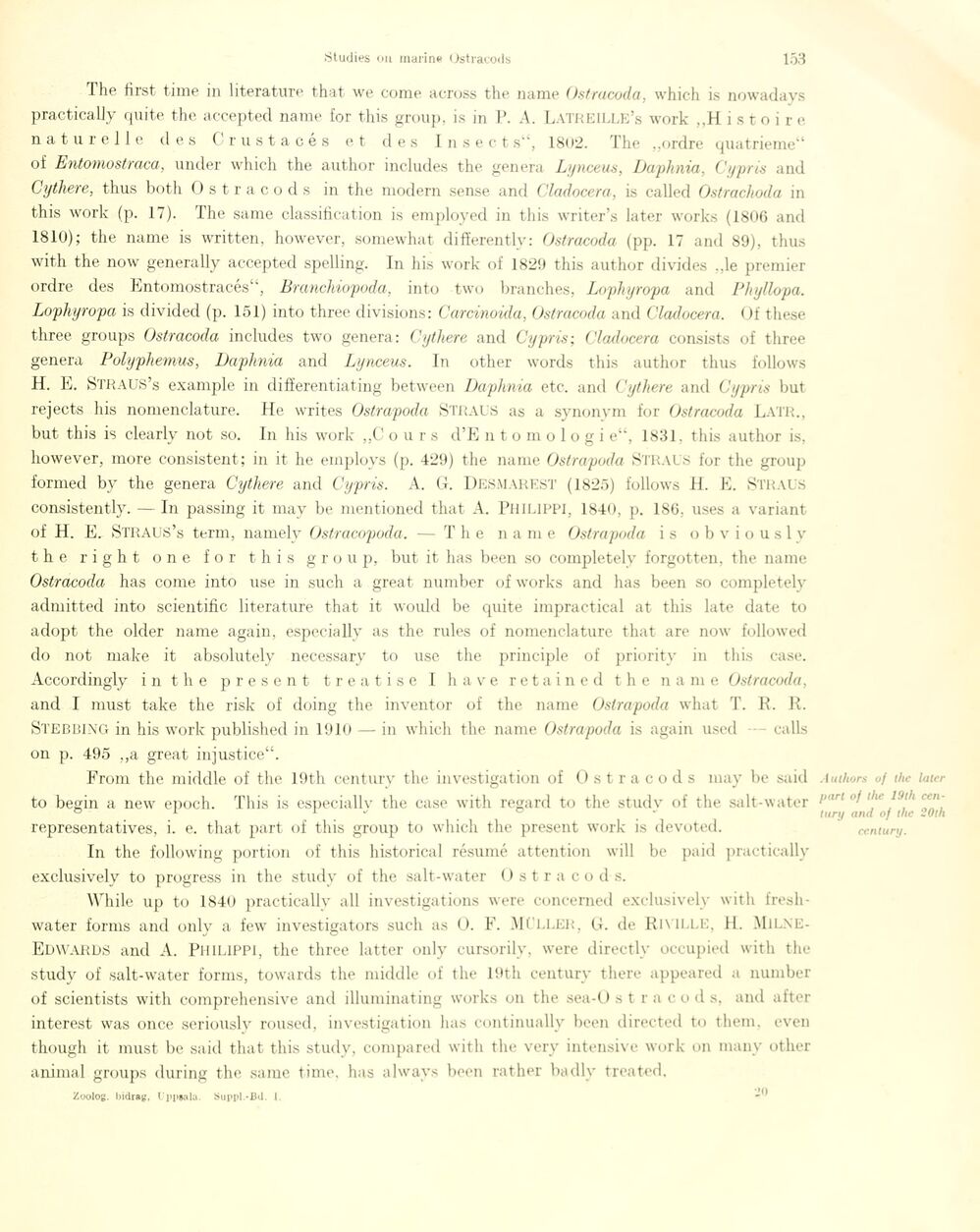
Full resolution (JPEG) - On this page / på denna sida - Sidor ...

<< prev. page << föreg. sida << >> nästa sida >> next page >>
Below is the raw OCR text
from the above scanned image.
Do you see an error? Proofread the page now!
Här nedan syns maskintolkade texten från faksimilbilden ovan.
Ser du något fel? Korrekturläs sidan nu!
This page has never been proofread. / Denna sida har aldrig korrekturlästs.
The first time in 1 iterature that we come across the name Ostracoda, which is nowadays
practicaljy quite the accepted name for this group, is in P. A. Latreille’s work „H i s t o i r e
naturelle des Crustacés et des I n s e c t s“, 1802. The ..ordre quatrième“
of Entomostraca, under which the author includes the genera Lyncem, Daphnia, Cypris and
Cythere, thus both Ostracods in the modern sense and Cladocera, is called Ostrachoda in
this work (p. 17). The same classification is employed in this writer’s later works (1806 and
1810); the name is written, however, somewhat di fierent ly : Ostracoda (pp. 17 and 89), thus
with the now generally accepted spelling. In his work of 1829 this author divides ..le premier
ordre des Entomostracés“, Branchiopoda, into two branches, Lophyropa and Phyllopa.
Lophyropa is divided (p. 151) into three divisions: Carcinoida, Ostracoda and Cladocera. Of these
three groups Ostracoda includes two genera: Cythere and Cypris; Cladocera consists of three
genera Polyphemus, Daphnia and Lynceus. In other words this author thus follows
H. E. STRAUS’s example in differentiating between Daphnia etc. and Cythere and Cypris but
rejects his nomenclature. He writes Ostrapoda Straus as a synonym for Ostracoda Latr.,
but this is clearly not so. In his work ,,C ours d’E ntomologi e“, 1831. this author is,
however, more consistent; in it he employs (p. 429) the name Ostrapoda STRAUS for the group
formed by the genera Cythere and Cypris. A. Gr. Desmarest (1825) follows H. E. STRAUS
consistently. — In passing it may be mentioned that A. PHILIPPI, 1840, p. 186, uses a variant
of H. E. STRAUS’s terni, namelv Ostracopoda. — T h e n a m e Ostrapoda i s o b v i o u s 1 y
the right one for this group, but it has been so completely forgotten, the name
Ostracoda has come into use in such a great number of works and lias been so completely
admitted into scientific literature that it would be cpiite impractical at this late date to
adopt the older name again, especially as the rules of nomenclature that are now followed
do not make it absolutely necessary to use the principle of priority in this case.
Accordingly in the present treatise I have ret a ined the name Ostracoda,
and I must take the risk of doing the inventor of the name Ostrapoda what T. R. R.
SïEBBING in his work published in 1910 — in which the name Ostrapoda is again used - calls
on p. 495 ,,a great injustice“.
From the middle of the 19th Century the investigation of Ostracods may be said a uthors uf tlu four
to begin a new epoch. This is especiallv the case with regard to the studv of the salt-water "■ ’/ 1
representatives, i. e. that part of this group to which the present work is devoted. ccnturi,.
In the following portion of this historica! résumé attention will be paid practically
exclusively to progress in the study of the salt-water O stracods.
While up to 1840 practically all investigations were concemed exclusively with
fresh-water forms and only a few investigators such as O. F. MUller, O. de Riville, H.
MlLNE-Edwards and A. Philippi, the three latter only cursorily, were directly occupied with the
study of salt-water forms, towards the middle of the 19th Century there appeared a number
of scientists with comprehensive and illuminating works on the sea-ü s t r a c o d s, and after
interest was once seriously roused, investigation has continually been directed to them. even
though it must be said that this study, compared with the very intensive Work on many other
animal groups during the same time, has always been rather badly treated.
Zoolog, hidrag. Uppsala. Suppl.-BU. I.
<< prev. page << föreg. sida << >> nästa sida >> next page >>